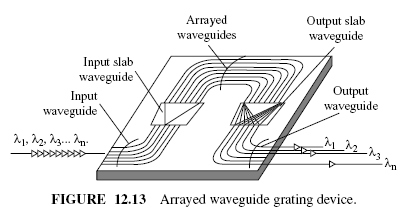Arrayed-Waveguide Grating
An arrayed waveguide grating (AWG ) is used in optical communications technology to split light into different colors ( = wavelengths), respectively, to combine single -color light signals back to a light signal. A division into different frequencies one uses to split the signals thus obtained on different optical waveguide or fiber optics. In the opposite direction one uses to combine single optical fiber strands back into a main line. These two processes are called depending on their direction and demultiplexing or multiplexing.
In modern telecommunications, a frequency spacing of 50 GHz between different frequencies of light is normal. State of the art in 2006, is a resolution of 96 frequencies over the entire available spectrum and an insertion loss of less than 4 dB.
Production
AWGs are on planar substrates - usually silicon wafers - made on which a coating is applied (eg, glass, silicon or polymer ) in which one can realize waveguides.
Principle
The function of an AWG can be compared with a grating spectrometer: Both serve the wavelength-selective spatial separation of the light.
The AWG consists of one or more input waveguides ( 1), the light in a planar free jet region (2). At the end of the free jet region, there are many waveguide (3 ), in which the light is coupled. These waveguides serve as a diffraction grating.
It is followed by another free-jet region (4), into which illuminate the grating waveguides at the end of the output waveguide ( 5) are located. Since the light paths having the grating waveguides (3) graduated lengths, the light interfering at the output waveguides (5) in such a way that each output channel receives only a specific wavelength range.
The whole assembly is in both directions, operated: (1 ) to (5), light of different wavelengths is divided into a plurality of fibers, which corresponds to a demultiplexer (5) according to (1 ), it is brought together into a fiber, which corresponds to a multiplexer.
Areas of application
AWGs are used in the optical communication technology in the WDM technique, if lasers of different wavelength are modulated with different data and are transmitted via a single optical fiber to the receiver. In an optical transport network, such light signals can be split by optical cross-connect, without conversion into an electric signal again and transmitted to different receivers. Also the recipient of the light is then divided and detected by wavelength. This allows the data capacity of an optical waveguide increase significantly. If only individual optical signals to or be taken away, to use add-drop multiplexer.









